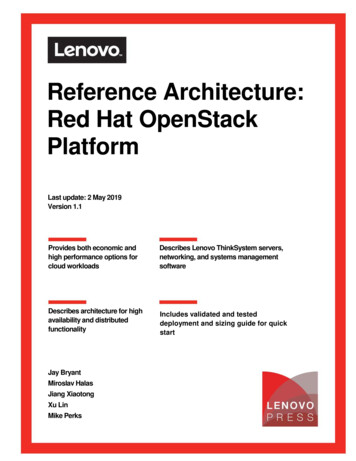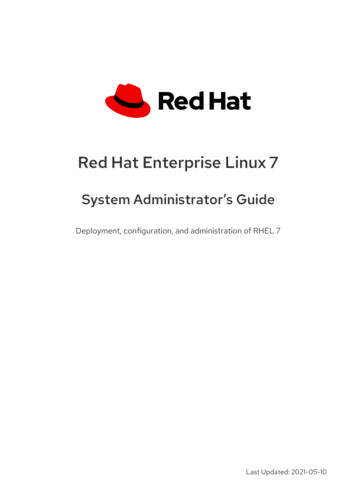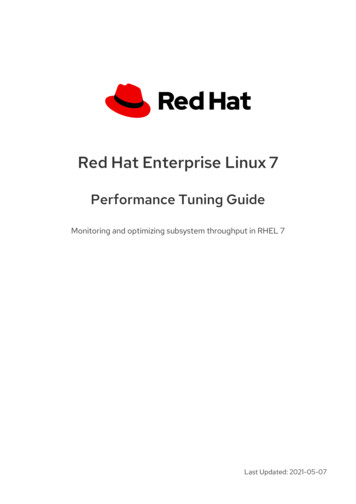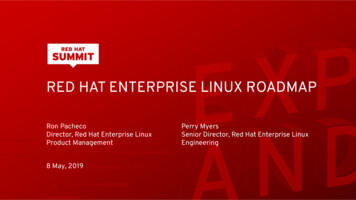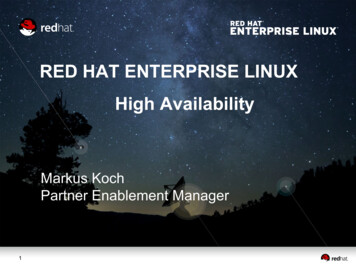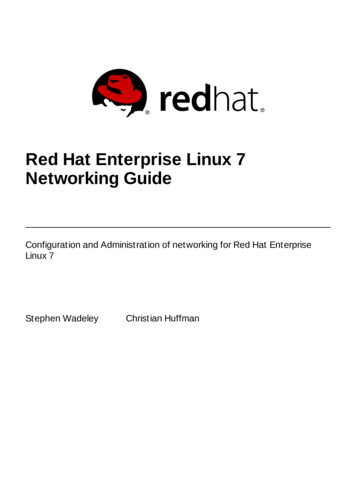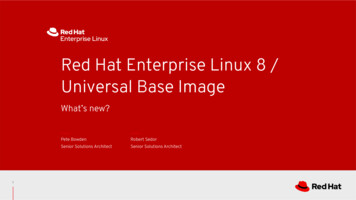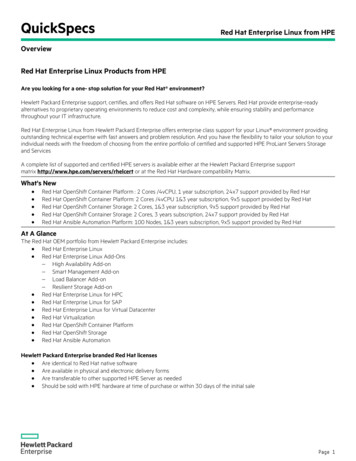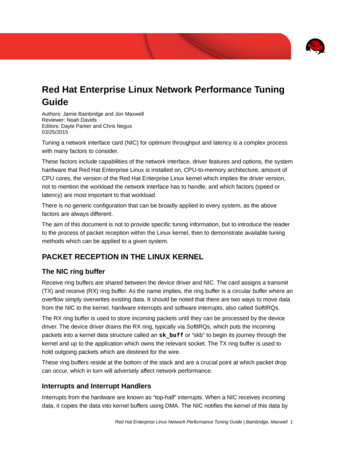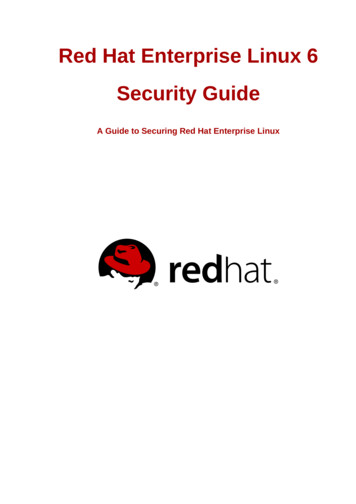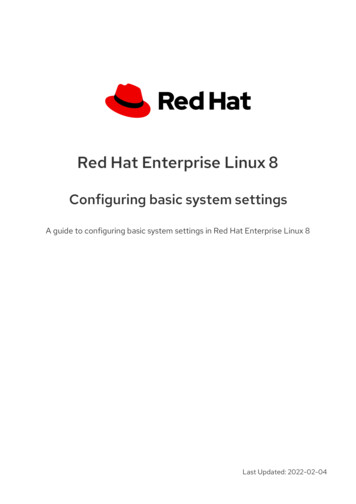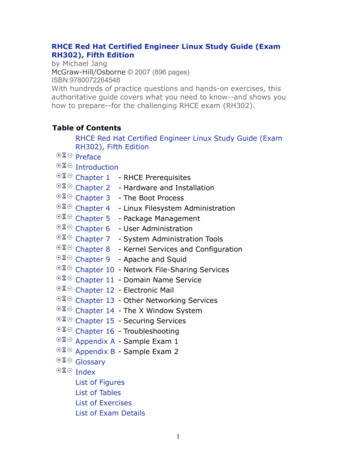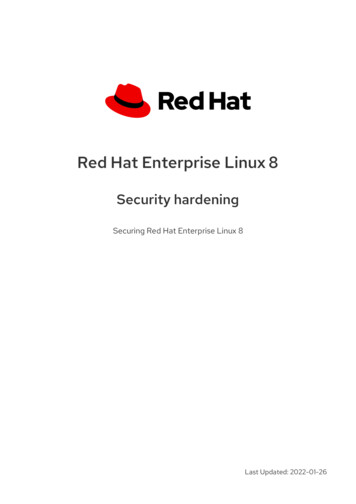
Transcription
Red Hat Enterprise Linux 8Security hardeningSecuring Red Hat Enterprise Linux 8Last Updated: 2022-01-26
Red Hat Enterprise Linux 8 Security hardeningSecuring Red Hat Enterprise Linux 8
Legal NoticeCopyright 2022 Red Hat, Inc.The text of and illustrations in this document are licensed by Red Hat under a Creative CommonsAttribution–Share Alike 3.0 Unported license ("CC-BY-SA"). An explanation of CC-BY-SA isavailable athttp://creativecommons.org/licenses/by-sa/3.0/. In accordance with CC-BY-SA, if you distribute this document or an adaptation of it, you mustprovide the URL for the original version.Red Hat, as the licensor of this document, waives the right to enforce, and agrees not to assert,Section 4d of CC-BY-SA to the fullest extent permitted by applicable law.Red Hat, Red Hat Enterprise Linux, the Shadowman logo, the Red Hat logo, JBoss, OpenShift,Fedora, the Infinity logo, and RHCE are trademarks of Red Hat, Inc., registered in the United Statesand other countries.Linux is the registered trademark of Linus Torvalds in the United States and other countries.Java is a registered trademark of Oracle and/or its affiliates.XFS is a trademark of Silicon Graphics International Corp. or its subsidiaries in the United Statesand/or other countries.MySQL is a registered trademark of MySQL AB in the United States, the European Union andother countries.Node.js is an official trademark of Joyent. Red Hat is not formally related to or endorsed by theofficial Joyent Node.js open source or commercial project.The OpenStack Word Mark and OpenStack logo are either registered trademarks/service marksor trademarks/service marks of the OpenStack Foundation, in the United States and othercountries and are used with the OpenStack Foundation's permission. We are not affiliated with,endorsed or sponsored by the OpenStack Foundation, or the OpenStack community.All other trademarks are the property of their respective owners.AbstractThis title assists users and administrators in learning the processes and practices of securingworkstations and servers against local and remote intrusion, exploitation, and malicious activity.Focused on Red Hat Enterprise Linux but detailing concepts and techniques valid for all Linuxsystems, this guide details the planning and the tools involved in creating a secured computingenvironment for the data center, workplace, and home. With proper administrative knowledge,vigilance, and tools, systems running Linux can be both fully functional and secured from mostcommon intrusion and exploit methods.
Table of ContentsTable of Contents. . . . . . . . . .OPENMAKING. . . . . . SOURCE. . . . . . . . . .MORE. . . . . . .INCLUSIVE. . . . . . . . . . . . . . . . . . . . . . . . . . . . . . . . . . . . . . . . . . . . . . . . . . . . . . . . . . . . . . . . . . . . . . . . . . . . 7. . . . . . . . . . . . . . . . . . . . . . . . . FEEDBACKPROVIDING. . . . . . . . . . . . ON. . . .RED. . . . .HAT. . . . .DOCUMENTATION. . . . . . . . . . . . . . . . . . . . . . . . . . . . . . . . . . . . . . . . . . . . . . . . . . . . . . . . . . . . . . . . . . . . . . 8. . . . . . . . . . . . .CHAPTER. . . . . . . . . . 1. .OVERVIEW. . . . . . . . . . . .OF. . . SECURITY. . . . . . . . . . . .HARDENING. . . . . . . . . . . . .IN. . .RHEL. . . . . . . . . . . . . . . . . . . . . . . . . . . . . . . . . . . . . . . . . . . . . . . . . . . . . 9. . . . . . . . . . . . .1.1. WHAT IS COMPUTER SECURITY?91.2. STANDARDIZING SECURITY91.3. CRYPTOGRAPHIC SOFTWARE AND CERTIFICATIONS91.4. SECURITY CONTROLS101.4.1. Physical controls101.4.2. Technical controls101.4.3. Administrative controls111.5. VULNERABILITY ASSESSMENT111.5.1. Defining assessment and testing111.5.2. Establishing a methodology for vulnerability assessment131.5.3. Vulnerability assessment tools1.6. SECURITY THREATS1.6.1. Threats to network security1.6.2. Threats to server security1.6.3. Threats to workstation and home PC security1.7. COMMON EXPLOITS AND ATTACKS131313141516.CHAPTER. . . . . . . . . . 2. . SECURING. . . . . . . . . . . .RHEL. . . . . . DURING. . . . . . . . . INSTALLATION. . . . . . . . . . . . . . . . . . . . . . . . . . . . . . . . . . . . . . . . . . . . . . . . . . . . . . . . . . . . . . . . . . . .20.2.1. BIOS AND UEFI SECURITY202.1.1. BIOS passwords2.1.2. Non-BIOS-based systems security20202.2. DISK PARTITIONING2.3. RESTRICTING NETWORK CONNECTIVITY DURING THE INSTALLATION PROCESS20212.4. INSTALLING THE MINIMUM AMOUNT OF PACKAGES REQUIRED2.5. POST-INSTALLATION PROCEDURES2121.CHAPTER. . . . . . . . . . 3. . SECURING. . . . . . . . . . . . SERVICES. . . . . . . . . . . . . . . . . . . . . . . . . . . . . . . . . . . . . . . . . . . . . . . . . . . . . . . . . . . . . . . . . . . . . . . . . . . . . . . . . . .23.3.1. SECURING RPCBIND233.2. SECURING RPC.MOUNTD243.3. SECURING NFS253.3.1. Securing NFS configuration253.3.2. Export options for securing an NFS server3.3.3. Mount options for securing an NFS client3.3.4. Firewall configuration for an NFS server3.4. SECURING FTP25262728Secure bannersPrevent anonymous access and uploadsSecure user accounts3.5. SECURE HTTP SERVERS3.5.1. Secure Apache HTTP servers28292930303.5.2. Secure NGINX servers32.CHAPTER. . . . . . . . . . 4. . .INSTALLING. . . . . . . . . . . . .A. .RHEL. . . . . .8. .SYSTEM. . . . . . . . . WITH. . . . . . FIPS. . . . . .MODE. . . . . . .ENABLED. . . . . . . . . . . . . . . . . . . . . . . . . . . . . . . . . . . . . . . . . . .34.4.1. FEDERAL INFORMATION PROCESSING STANDARD (FIPS)344.2. INSTALLING THE SYSTEM WITH FIPS MODE ENABLED344.3. ADDITIONAL RESOURCES35. . . . . . . . . . . 5.CHAPTER. . USING. . . . . . . .SYSTEM-WIDE. . . . . . . . . . . . . . . .CRYPTOGRAPHIC. . . . . . . . . . . . . . . . . . .POLICIES. . . . . . . . . . . . . . . . . . . . . . . . . . . . . . . . . . . . . . . . . . . . . . . . . . . .36.1
Red Hat Enterprise Linux 8 Security hardening5.1. SYSTEM-WIDE CRYPTOGRAPHIC POLICIESTool for managing crypto policiesStrong crypto defaults by removing insecure cipher suites and protocolsCipher suites and protocols disabled in all policy levels36373737Cipher suites and protocols enabled in the crypto-policies levels5.2. SWITCHING THE SYSTEM-WIDE CRYPTOGRAPHIC POLICY TO MODE COMPATIBLE WITH EARLIERRELEASES5.3. SWITCHING THE SYSTEM TO FIPS MODE5.4. ENABLING FIPS MODE IN A CONTAINER5.4.1. Enabling FIPS mode in a container in RHEL 8.238393940405.4.2. Enabling FIPS mode in a container in RHEL 8.1 and earlier5.5. LIST OF RHEL APPLICATIONS USING CRYPTOGRAPHY THAT IS NOT COMPLIANT WITH FIPS 140-25.6. EXCLUDING AN APPLICATION FROM FOLLOWING SYSTEM-WIDE CRYPTO POLICIES5.6.1. Examples of opting out of system-wide crypto policies414142425.7. CUSTOMIZING SYSTEM-WIDE CRYPTOGRAPHIC POLICIES WITH SUBPOLICIES5.8. DISABLING SHA-1 BY CUSTOMIZING A SYSTEM-WIDE CRYPTOGRAPHIC POLICY5.9. CREATING AND SETTING A CUSTOM SYSTEM-WIDE CRYPTOGRAPHIC POLICY5.10. ADDITIONAL RESOURCES43454647.CHAPTER. . . . . . . . . . 6. . .SETTING.A. . CUSTOM. . . . . . . . . . CRYPTOGRAPHIC. . . . . . . . . . . . . . . . . . . .POLICY. . . . . . . . ACROSS. . . . . . . . . .SYSTEMS. . . . . . . . . . . . . . . . . . . . . . . . . . . . . . . . . . .48.6.1. CRYPTO POLICIES SYSTEM ROLE VARIABLES AND FACTS486.2. SETTING A CUSTOM CRYPTOGRAPHIC POLICY USING THE CRYPTO POLICIES SYSTEM ROLE6.3. ADDITIONAL RESOURCES4850. . . . . . . . . . . 7.CHAPTER. . CONFIGURING. . . . . . . . . . . . . . . . APPLICATIONS. . . . . . . . . . . . . . . . .TO. . . USE. . . . . CRYPTOGRAPHIC. . . . . . . . . . . . . . . . . . . HARDWARE. . . . . . . . . . . . . THROUGH. . . . . . . . . . . .PKCS. . . . . .#11.517.1. CRYPTOGRAPHIC HARDWARE SUPPORT THROUGH PKCS #11517.2. USING SSH KEYS STORED ON A SMART CARD7.3. CONFIGURING APPLICATIONS TO AUTHENTICATE USING CERTIFICATES FROM SMART CARDS51537.4. USING HSMS PROTECTING PRIVATE KEYS IN APACHE7.5. USING HSMS PROTECTING PRIVATE KEYS IN NGINX53547.6. ADDITIONAL RESOURCES54. . . . . . . . . . . 8.CHAPTER. . .CONTROLLING. . . . . . . . . . . . . . . .ACCESS. . . . . . . . . TO. . . .SMART. . . . . . . .CARDS. . . . . . . .USING. . . . . . .POLKIT. . . . . . . . . . . . . . . . . . . . . . . . . . . . . . . . . . . . . . . . . .55.8.1. SMART-CARD ACCESS CONTROL THROUGH POLKIT8.2. TROUBLESHOOTING PROBLEMS RELATED TO PC/SC AND POLKIT55558.3. DISPLAYING MORE DETAILED INFORMATION ABOUT POLKIT AUTHORIZATION TO PC/SC578.4. ADDITIONAL RESOURCES58.CHAPTER. . . . . . . . . . 9. . .USING. . . . . . .SHARED. . . . . . . . . SYSTEM. . . . . . . . . CERTIFICATES. . . . . . . . . . . . . . . . . . . . . . . . . . . . . . . . . . . . . . . . . . . . . . . . . . . . . . . . . . . . . . . . . . . . .59.9.1. THE SYSTEM-WIDE TRUST STORE599.2. ADDING NEW CERTIFICATES9.3. MANAGING TRUSTED SYSTEM CERTIFICATES9.4. ADDITIONAL RESOURCES596061. . . . . . . . . . . 10.CHAPTER. . . SCANNING. . . . . . . . . . . . THE. . . . . SYSTEM. . . . . . . . . FOR. . . . . CONFIGURATION. . . . . . . . . . . . . . . . . . . COMPLIANCE. . . . . . . . . . . . . . . AND. . . . . VULNERABILITIES. . . . . . . . . . . . . . . . . . . . . . . .62.10.1. CONFIGURATION COMPLIANCE TOOLS IN RHEL10.2. VULNERABILITY SCANNING10.2.1. Red Hat Security Advisories OVAL feed10.2.2. Scanning the system for vulnerabilities626310.2.3. Scanning remote systems for vulnerabilities6410.3. CONFIGURATION COMPLIANCE SCANNING10.3.1. Configuration compliance in RHEL10.3.2. Possible results of an OpenSCAP scan26262656566
Table of Contents10.3.3. Viewing profiles for configuration compliance6610.3.4. Assessing configuration compliance with a specific baseline6710.4. REMEDIATING THE SYSTEM TO ALIGN WITH A SPECIFIC BASELINE10.5. REMEDIATING THE SYSTEM TO ALIGN WITH A SPECIFIC BASELINE USING THE SSG ANSIBLEPLAYBOOK686910.6. CREATING A REMEDIATION ANSIBLE PLAYBOOK TO ALIGN THE SYSTEM WITH A SPECIFIC BASELINE7010.7. CREATING A REMEDIATION BASH SCRIPT FOR A LATER APPLICATION7110.8. SCANNING THE SYSTEM WITH A CUSTOMIZED PROFILE USING SCAP WORKBENCH10.8.1. Using SCAP Workbench to scan and remediate the system10.8.2. Customizing a security profile with SCAP Workbench71717310.8.3. Related information7510.9. DEPLOYING SYSTEMS THAT ARE COMPLIANT WITH A SECURITY PROFILE IMMEDIATELY AFTER ANINSTALLATION7510.9.1. Profiles not compatible with Server with GUI7510.9.2. Deploying baseline-compliant RHEL systems using the graphical installation10.9.3. Deploying baseline-compliant RHEL systems using Kickstart767710.10. SCANNING CONTAINER AND CONTAINER IMAGES FOR VULNERABILITIES7810.11. ASSESSING SECURITY COMPLIANCE OF A CONTAINER OR A CONTAINER IMAGE WITH A SPECIFICBASELINE7910.12. SCAP SECURITY GUIDE PROFILES SUPPORTED IN RHEL 88010.13. RELATED INFORMATION85.CHAPTER. . . . . . . . . . 11. . .CHECKING. . . . . . . . . . . .INTEGRITY. . . . . . . . . . . WITH. . . . . . .AIDE. . . . . . . . . . . . . . . . . . . . . . . . . . . . . . . . . . . . . . . . . . . . . . . . . . . . . . . . . . . . . . . .86.11.1. INSTALLING AIDE8611.2. PERFORMING INTEGRITY CHECKS WITH AIDE11.3. UPDATING AN AIDE DATABASE868711.4. FILE-INTEGRITY TOOLS: AIDE AND IMA8711.5. ADDITIONAL RESOURCES88.CHAPTER. . . . . . . . . . 12. . . ENHANCING. . . . . . . . . . . . . .SECURITY. . . . . . . . . . .WITH. . . . . .THE. . . . .KERNEL. . . . . . . . .INTEGRITY. . . . . . . . . . . .SUBSYSTEM. . . . . . . . . . . . . . . . . . . . . . . . . . . . . . . . . . . . .89.12.1. THE KERNEL INTEGRITY SUBSYSTEM8912.2. INTEGRITY MEASUREMENT ARCHITECTURE9012.3. EXTENDED VERIFICATION MODULE12.4. TRUSTED AND ENCRYPTED KEYS909012.5. WORKING WITH TRUSTED KEYS12.6. WORKING WITH ENCRYPTED KEYS919212.7. ENABLING INTEGRITY MEASUREMENT ARCHITECTURE AND EXTENDED VERIFICATION MODULE9312.8. COLLECTING FILE HASHES WITH INTEGRITY MEASUREMENT ARCHITECTURE9612.9. ADDITIONAL RESOURCES97.CHAPTER. . . . . . . . . . 13. . . ENCRYPTING. . . . . . . . . . . . . . .BLOCK. . . . . . . .DEVICES. . . . . . . . . .USING. . . . . . .LUKS. . . . . . . . . . . . . . . . . . . . . . . . . . . . . . . . . . . . . . . . . . . . . . . . . . . . . .98.13.1. LUKS DISK ENCRYPTION9813.2. LUKS VERSIONS IN RHEL9913.3. OPTIONS FOR DATA PROTECTION DURING LUKS2 RE-ENCRYPTION10013.4. ENCRYPTING EXISTING DATA ON A BLOCK DEVICE USING LUKS210013.5. ENCRYPTING EXISTING DATA ON A BLOCK DEVICE USING LUKS2 WITH A DETACHED HEADER13.6. ENCRYPTING A BLANK BLOCK DEVICE USING LUKS210110213.7. CREATING A LUKS ENCRYPTED VOLUME USING THE STORAGE ROLE103CHAPTER 14. CONFIGURING AUTOMATED UNLOCKING OF ENCRYPTED VOLUMES USING POLICY-BASED. . . . . . . . . . . . . . . . . . . . . . . . . . . . . . . . . . . . . . . . . . . . . . . . . . . . . . . . . . . . . . . . . . . . . . . . . . . . . . . . . . . . . . . . . . . . . . . . . . . . . . . . . . .105DECRYPTION.14.1. NETWORK-BOUND DISK ENCRYPTION10514.2. INSTALLING AN ENCRYPTION CLIENT - CLEVIS10614.3. DEPLOYING A TANG SERVER WITH SELINUX IN ENFORCING MODE1073
Red Hat Enterprise Linux 8 Security hardening14.4. ROTATING TANG SERVER KEYS AND UPDATING BINDINGS ON CLIENTS14.5. CONFIGURING AUTOMATED UNLOCKING USING A TANG KEY IN THE WEB CONSOLE10811014.6. BASIC NBDE AND TPM2 ENCRYPTION-CLIENT OPERATIONS11314.7. CONFIGURING MANUAL ENROLLMENT OF LUKS-ENCRYPTED VOLUMES11514.8. CONFIGURING MANUAL ENROLLMENT OF LUKS-ENCRYPTED VOLUMES USING A TPM 2.0 POLICY14.9. REMOVING A CLEVIS PIN FROM A LUKS-ENCRYPTED VOLUME MANUALLY14.10. CONFIGURING AUTOMATED ENROLLMENT OF LUKS-ENCRYPTED VOLUMES USING KICKSTART11912014.11. CONFIGURING AUTOMATED UNLOCKING OF A LUKS-ENCRYPTED REMOVABLE STORAGE DEVICE14.12. DEPLOYING HIGH-AVAILABILITY NBDE SYSTEMS14.12.1. High-available NBDE using Shamir’s Secret Sharing14.12.1.1. Example 1: Redundancy with two Tang servers14.12.1.2. Example 2: Shared secret on a Tang server and a TPM device14.13. DEPLOYMENT OF VIRTUAL MACHINES IN A NBDE NETWORK11712112212212312312414.14. BUILDING AUTOMATICALLY-ENROLLABLE VM IMAGES FOR CLOUD ENVIRONMENTS USING NBDE12414.15. DEPLOYING TANG AS A CONTAINER14.16. INTRODUCTION TO THE CLEVIS AND TANG SYSTEM ROLES12512614.17. USING THE NBDE SERVER SYSTEM ROLE FOR SETTING UP MULTIPLE TANG SERVERS12714.18. USING THE NBDE CLIENT SYSTEM ROLE FOR SETTING UP MULTIPLE CLEVIS CLIENTS12814.19. ADDITIONAL RESOURCES129. . . . . . . . . . . 15.CHAPTER. . . AUDITING. . . . . . . . . . . THE. . . . .SYSTEM. . . . . . . . . . . . . . . . . . . . . . . . . . . . . . . . . . . . . . . . . . . . . . . . . . . . . . . . . . . . . . . . . . . . . . . . . . . . . .131.15.1. LINUX AUDIT13115.2. AUDIT SYSTEM ARCHITECTURE15.3. CONFIGURING AUDITD FOR A SECURE ENVIRONMENT13213315.4. STARTING AND CONTROLLING AUDITD13415.5. UNDERSTANDING AUDIT LOG FILES13515.6. USING AUDITCTL FOR DEFINING AND EXECUTING AUDIT RULES13915.7. DEFINING PERSISTENT AUDIT RULES15.8. USING PRE-CONFIGURED RULES FILES14014015.9. USING AUGENRULES TO DEFINE PERSISTENT RULES14115.10. DISABLING AUGENRULES14115.11. SETTING UP AUDIT TO MONITOR SOFTWARE UPDATES14215.12. MONITORING USER LOGIN TIMES WITH AUDIT15.13. ADDITIONAL RESOURCES144145. . . . . . . . . . . 16.CHAPTER. . . BLOCKING. . . . . . . . . . . . AND. . . . . ALLOWING. . . . . . . . . . . . .APPLICATIONS. . . . . . . . . . . . . . . . USING. . . . . . . FAPOLICYD. . . . . . . . . . . . . . . . . . . . . . . . . . . . . . . . . . . . . . . .146.16.1. INTRODUCTION TO FAPOLICYD14616.2. DEPLOYING FAPOLICYD14716.3. MARKING FILES AS TRUSTED USING AN ADDITIONAL SOURCE OF TRUST14716.4. ADDING CUSTOM ALLOW AND DENY RULES FOR FAPOLICYD16.5. ENABLING FAPOLICYD INTEGRITY CHECKS14815016.6. TROUBLESHOOTING PROBLEMS RELATED TO FAPOLICYD15116.7. ADDITIONAL RESOURCES153. . . . . . . . . . . 17.CHAPTER. . . PROTECTING. . . . . . . . . . . . . . .SYSTEMS. . . . . . . . . . AGAINST. . . . . . . . . . .INTRUSIVE. . . . . . . . . . . USB. . . . . DEVICES. . . . . . . . . . . . . . . . . . . . . . . . . . . . . . . . . . . . . . . . .154.417.1. USBGUARD15417.2. INSTALLING USBGUARD17.3. BLOCKING AND AUTHORIZING A USB DEVICE USING CLI15415517.4. PERMANENTLY BLOCKING AND AUTHORIZING A USB DEVICE15617.5. CREATING A CUSTOM POLICY FOR USB DEVICES157
Table of Contents17.6. CREATING A STRUCTURED CUSTOM POLICY FOR USB DEVICES15817.7. AUTHORIZING USERS AND GROUPS TO USE THE USBGUARD IPC INTERFACE16017.8. LOGGING USBGUARD AUTHORIZATION EVENTS TO THE LINUX AUDIT LOG16117.9. ADDITIONAL RESOURCES1615
Red Hat Enterprise Linux 8 Security hardening6
MAKING OPEN SOURCE MORE INCLUSIVEMAKING OPEN SOURCE MORE INCLUSIVERed Hat is committed to replacing problematic language in our code, documentation, and webproperties. We are beginning with these four terms: master, slave, blacklist, and whitelist. Because of theenormity of this endeavor, these changes will be implemented gradually over several upcoming releases.For more details, see our CTO Chris Wright’s message .7
Red Hat Enterprise Linux 8 Security hardeningPROVIDING FEEDBACK ON RED HAT DOCUMENTATIONWe appreciate your input on our documentation. Please let us know how we could make it better. To doso:For simple comments on specific passages:1. Make sure you are viewing the documentation in the Multi-page HTML format. In addition,ensure you see the Feedback button in the upper right corner of the document.2. Use your mouse cursor to highlight the part of text that you want to comment on.3. Click the Add Feedback pop-up that appears below the highlighted text.4. Follow the displayed instructions.For submitting more complex feedback, create a Bugzilla ticket:1. Go to the Bugzilla website.2. As the Component, use Documentation.3. Fill in the Description field with your suggestion for improvement. Include a link to therelevant part(s) of documentation.4. Click Submit Bug.8
CHAPTER 1. OVERVIEW OF SECURITY HARDENING IN RHELCHAPTER 1. OVERVIEW OF SECURITY HARDENING IN RHELDue to the increased reliance on powerful, networked computers to help run businesses and keep trackof our personal information, entire industries have been formed around the practice of network andcomputer security. Enterprises have solicited the knowledge and skills of security experts to properlyaudit systems and tailor solutions to fit the operating requirements of their organization. Because mostorganizations are increasingly dynamic in nature, their workers are accessing critical company ITresources locally and remotely, hence the need for secure computing environments has become morepronounced.Unfortunately, many organizations, as well as individual users, regard security as more of anafterthought, a process that is overlooked in favor of increased power, productivity, convenience, easeof use, and budgetary concerns. Proper security implementation is often enacted postmortem — afteran unauthorized intrusion has already occurred. Taking the correct measures prior to connecting a site toan untrusted network, such as the Internet, is an effective means of thwarting many attempts atintrusion.1.1. WHAT IS COMPUTER SECURITY?Computer security is a general term that covers a wide area of computing and information processing.Industries that depend on computer systems and networks to conduct daily business transactions andaccess critical information regard their data as an important part of their overall assets. Several termsand metrics have entered our daily business vocabulary, such as total cost of ownership (TCO), return oninvestment (ROI), and quality of service (QoS). Using these metrics, industries can calculate aspectssuch as data integrity and high-availability (HA) as part of their planning and process managementcosts. In some industries, such as electronic commerce, the availability and trustworthiness of data canmean the difference between success and failure.1.2. STANDARDIZING SECURITYEnterprises in every industry rely on regulations and rules that are set by standards-making bodies suchas the American Medical Association (AMA) or the Institute of Electrical and Electronics Engineers(IEEE). The same concepts hold true for information security. Many security consultants and vendorsagree upon the standard security model known as CIA, or Confidentiality, Integrity, and Availability . Thisthree-tiered model is a generally accepted component to assessing risks of sensitive information andestablishing security policy. The following describes the CIA model in further detail:Confidentiality — Sensitive information must be available only to a set of pre-defined individuals.Unauthorized transmission and usage of information should be restricted. For example,confidentiality of information ensures that a customer’s personal or financial information is notobtained by an unauthorized individual for malicious purposes such as identity theft or creditfraud.Integrity — Information should not be altered in ways that render it incomplete or incorrect.Unauthorized users should be restricted from the ability to modify or destroy sensitiveinformation.Availability — Information should be accessible to authorized users any time that it is needed.Availability is a warranty that information can be obtained with an agreed-upon frequency andtimeliness. This is often measured in terms of percentages and agreed to formally in ServiceLevel Agreements (SLAs) used by network service providers and their enterprise clients.1.3. CRYPTOGRAPHIC SOFTWARE AND CERTIFICATIONSRed Hat Enterprise Linux undergoes several security certifications, such as FIPS 140-2 or Common9
Red Hat Enterprise Linux 8 Security hardeningRed Hat Enterprise Linux undergoes several security certifications, such as FIPS 140-2 or CommonCriteria (CC), to ensure that industry best practices are followed.The RHEL 8 core crypto components Knowledgebase article provides an overview of the Red HatEnterprise Linux 8 core crypto components, documenting which are they, how are they selected, howare they integrated into the operating system, how do they support hardware security modules andsmart cards, and how do crypto certifications apply to them.1.4. SECURITY CONTROLSComputer security is often divided into three distinct main categories, commonly referred to ascontrols:PhysicalTechnicalAdministrativeThese three broad categories define the main objectives of proper security implementation. Withinthese controls are sub-categories that further detail the controls and how to implement them.1.4.1. Physical controlsPhysical control is the implementation of security measures in a defined structure used to deter orprevent unauthorized access to sensitive material. Examples of physical controls are:Closed-circuit surveillance camerasMotion or thermal alarm systemsSecurity guardsPicture IDsLocked and dead-bolted steel doorsBiometrics (includes fingerprint, voice, face, iris, handwriting, and other automated methodsused to recognize individuals)1.4.2. Technical controlsTechnical controls use technology as a basis for controlling the access and usage of sensitive datathroughout a physical structure and over a network. Technical controls are far-reaching in scope andencompass such technologies as:EncryptionSmart cardsNetwork authenticationAccess control lists (ACLs)File integrity auditing software10
CHAPTER 1. OVERVIEW OF SECURITY HARDENING IN RHEL1.4.3. Administrative controlsAdministrative controls define the human factors of security. They involve all levels of personnel withinan organization and determine which users have access to what resources and information by suchmeans as:Training and awarenessDisaster preparedness and recovery plansPersonnel recruitment and separation strategiesPersonnel registration and accounting1.5. VULNERABILITY ASSESSMENTGiven time, resources, and motivation, an attacker can break into nearly any system. All of the securityprocedures and technologies currently available cannot guarantee that any systems are completely safefrom intrusion. Routers help secure gateways to the Internet. Firewalls help secure the edge of thenetwork. Virtual Private Networks safely pass data in an encrypted stream. Intrusion detection systemswarn you of malicious activity. However, the success of each of these technologies is dependent upon anumber of variables, including:The expertise of the staff responsible for configuring, monitoring, and maintaining thetechnologies.The ability to patch and update services and kernels quickly and efficiently.The ability of those responsible to keep constant vigilance over the network.Given the dynamic state of data systems and technologies, securing corporate resources can be quitecomplex. Due to this complexity, it is often difficult to find expert resources for all of your systems. Whileit is possible to have personnel knowledgeable in many areas of information security at a high level, it isdifficult to retain staff who are experts in more than a few subject areas. This is mainly because eachsubject area of information security requires constant attention and focus. Information security does notstand still.A vulnerability assessment is an internal audit of your network and system security; the results of whichindicate the confidentiality, integrity, and availability of your network. Typically, vulnerability assessmentstarts with a reconnaissance phase, during which important data regarding the target systems andresources is gathered. This phase leads to the system readiness phase, whereby the target is essentiallychecked for all known vulnerabilities. The readiness phase culminates in the reporting phase, where thefindings are classified into categories of high, medium, and low risk; and methods for improving thesecurity (or mitigating the risk of vulnerability) of the target are discussedIf you were to perform a vulnerability assessment of your home, you would likely check each door to yourhome to see if they are closed and locked. You would also check every window, making sure that theyclosed completely and latch correctly. This same concept applies to systems, networks, and electronicdata. Malicious users are the thieves and vandals of your data. Focus on their tools, mentality, andmotivations, and you can then react swiftly to their actions.1.5.1. Defining assessment and testingVulnerability assessments may be broken down into one of two types: outside looking in and insidelooking around.When performing an outside-looking-in vulnerability assessment, you are attempting to compromise11
Red Hat Enterprise Linux 8 Security hardeningWhen performing an outside-looking-in vulnerability assessment, you are attempting to compromiseyour systems from the outside. Being external to your company provides you with the cracker’s point ofview. You see what a cracker sees — publicly-routable IP addresses, systems on your DMZ, externalinterfaces of your firewall, and more. DMZ stands for "demilitarized zone", which corresponds to acomputer or small subnetwork that sits between a trusted internal network, such as a corporate privateLAN, and an untrusted external network, such as the public Internet. Typically, the DMZ contains devicesaccessible to Internet traffic, such as web (HTTP) servers, FTP servers, SMTP (e-mail) servers and DNSservers.When you perform an inside-looking-around vulnerability assessment, you are at an advantage since youare internal and your status is elevated to trusted. This is the point of view you and your co-workers haveonce logged on to your systems. You see print servers, file servers, databases, and other resources.There are striking distinctions between the two types of vulnerability assessments. Being internal to yourcompany gives you more privileges than an outsider. In most organizations, security is configured tokeep intruders out. Very little is done to secure the internals of the organization (such as departmentalfirewalls, user-level access controls, and authentication procedures for internal resources). Typically,there are many more resources when looking around inside as most systems are internal to a company.Once you are outside the company, your status is untrusted. The systems and resources available to youexternally are usually very limited.Consider the difference between vulnerability assessments and penetration tests. Think of a vulnerabilityassessment as the first step to a penetration test. The information gleaned from the assessment is usedfor testing. Whereas the assessment is undertaken to check for holes and potential vulnerabilities, thepenetration testing actually attempts to exploit the findings.Assessing network infrastructure is a dynamic process. Security, both information and physical, isdynamic. Performing an assessment shows an overview, which can turn up false positives and falsenegatives. A false positive is a result, where the tool finds vulnerabilities which in reality do not exist. Afalse negative is when it omits actual vulnerabilities.Security administrators are only as good as the tools they use and the knowledge they retain. Take anyof the assessment tools currently available, run them against your system, and it is almost a guaranteethat there are some false positives. Whether by program fault or user error, the result is the same. Thetool may find false positives, or, even worse, false negatives.Now that the difference between a vulnerability assessment and a penetration test is defined, take thefindings of the assessment and review them carefully before conducting a penetration test as part ofyour new best practices approach. WARNINGDo not attempt to exploit vulnerabilities on production systems. Doing so can haveadverse effects on productivity and efficiency of your systems and network.The following list examines some of the benefits of performing vulnerability assessments.Creates proactive focus on information security.Finds potential exploits before crackers find them.Results in systems being kept up to date and patched.12 page
Jan 14, 2022 · Red Hat, as the licensor of this document, waives the right to enforce, and agrees not to assert, Section 4d of CC-BY-SA to the fullest extent permitted by applicable law. Red Hat, Red Hat Enterprise Linux, the Shadowman l
